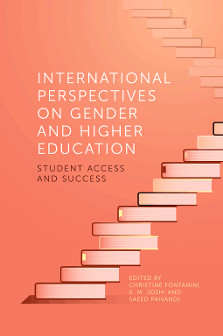
Index
International Perspectives on Gender and Higher Education
ISBN: 978-1-83909-887-1, eISBN: 978-1-83909-886-4
Publication date: 26 November 2020
Citation
(2020), "Index", Fontanini, C., Joshi, K.M. and Paivandi, S. (Ed.) International Perspectives on Gender and Higher Education, Emerald Publishing Limited, Leeds, pp. 291-300. https://doi.org/10.1108/978-1-83909-886-420201019
Publisher
:Emerald Publishing Limited
Copyright © 2021 Emerald Publishing Limited.
INDEX
- Prelims
- Chapter 1 A Difficult Balance: Policies on Gender Imbalances in the Higher Education Student Population in Flanders
- Chapter 2 Gender in Higher Education: Portuguese Landscape
- Chapter 3 Girls in French Higher Education: Real Progress despite Persistent Inequalities in Scientific and Technological Fields
- Chapter 4 Gender and Higher Education: The Greek Case
- Chapter 5 Italy: Gender Segregation and Higher Education
- Chapter 6 Gender and Higher Education: The Hungarian Case
- Chapter 7 Gender and Higher Education in Spain: A Changing and Hopeful Landscape
- Chapter 8 Girls, Orientation in Science-based Higher Education: The Case of Côte d'Ivoire
- Chapter 9 Feminization of Japanese Higher Education and Career Pathway: From “Interruption” to “Upward Mobility”
- Chapter 10 Women in Higher Education in India: Historical Influences, Contemporary Narratives, and the Way Ahead
- Chapter 11 Feminization of Higher Education in Iran: Paradoxes and Complexities
- Chapter 12 Women's Empowerment through Higher Education: The Case of Bangladesh
- Chapter 13 Women's Access to Brazilian Higher Education: The Case of the Federal University of Santa Catarina
- Chapter 14 Access and Gender Equity in Colombian Higher Education: From Aspirations to Success
- Chapter 15 Women in Canadian Higher Education: The Paradox of Gender Parity and Equity
- Index